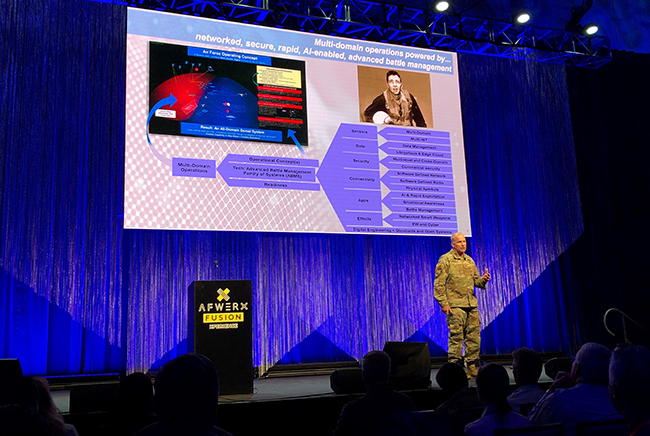
Maj. Gen. Michael Fantini, director of Air Force Warfighting Integration Capability, discusses multi-domain operations during a July 23 talk at the 2019 AFWERX "Fusion Xperience" conference in Las Vegas. Air Force Materiel Command photo via Twitter.
LAS VEGAS—A high-level governance body could soon emerge to help oversee how the Defense Department collectively pursues multi-domain operations, an Air Force official told Air Force Magazine.
To truly succeed at quickly calling up any combat capability, anytime and anywhere, multi-domain operations can’t solely be an Air Force venture. Yet the idea is still largely being pushed within the services rather than from a high-level, Pentagon-wide perch that can pull together each military branch and develop tools that function across all.
Maj. Gen. Michael Fantini, director of Air Force Warfighting Integration Capability, said one of the first attempts to broaden multi-domain operations to the joint force will take place at a command and control experimentation center at Nellis AFB, Nev., known as the “Shadow Operations Center.”
The Air Force said it wants to use the Shadow OC as a testbed to further automate aspects of the Air Operations Center, introduce artificial intelligence as well as new space and cyber C2 tools, migrate its data to cloud infrastructure, and vet the fledgling multi-domain system with live flight tests. Fantini envisions it becoming a “joint intelligence community- and coalition-friendly experimentation environment so that we can welcome the Army, the Air Force, the Navy, the Marines, intelligence community, and coalition partners to come in and figure out how to do these things.”
“Every day you turn over a rock and someone’s doing something they consider to be multi-domain command and control, and while there’s goodness in that, we need to be able to focus our work,” he said.
Over the next year, those entities will piece together a plan to align the MDC2-related work underway in each service and in other groups such as the Defense Advanced Research Projects Agency, Fantini said. That’s crucial to making sure that military systems are connected in combat regardless of which service owns them, an issue that new, DOD-level leadership is sure to tackle as well.
“Out of this work at the Shadow Operations Center, we are probably going to see a governance body where [the Office of the Secretary of Defense] and the Joint Staff come together to shepherd these things along,” he said. “I think it’s going to stand up over the next three or four months.”
Simultaneously, a planning team that first met in June will reconvene in August to plan scenarios for an event at the Shadow OC in October. The Pentagon’s Joint Requirements Oversight Council, chaired by the vice chairman of the Joint Chiefs of Staff, is already involved in those talks.
This greater push to think of MDO as a wider venture comes after the Air Force and Army collaborated on a two-party MDO vision and after USAF brought joint and coalition partners in for more preliminary talks about how to define and carry out the concept. In 2017, the Air Force held a yearlong enterprise review of multi-domain command and control that included joint input.
Military investment will grow as DOD decides on a way forward. Fantini, who oversees a team that charts future force needs and plans servicewide budget priorities, said joint, multi-domain operations will begin to play a more prominent role in the 2021 spending cycle.